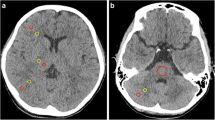Abstract.
The aim of this study was to evaluate feasibility of reporting brain CT examinations on liquid crystal display (LCD) flat-screen monitors vs state-of-the-art cathode-ray-tube (CRT) monitors. Ninety-five brain CT examinations of 95 patients were displayed on Picture archiving and communications system (PACS) workstations equipped either with a dedicated medical imaging LCD colour monitor or on a high-resolution CRT which is used for routine reporting of CT, MRI and digital radiography images in our institution. Fifty cases were negative and 45 cases were positive for early brain infarction (EBI), the latter being defined by a combination of one or more signs: dense artery; hypodensity of brain parenchyma; and local brain swelling verified by control scans. Ten radiologists had to rate presence or absence of EBI on a five-point scale. Ratings were evaluated by CORROC2 ROC software and areas under the ROC curve (Az) were computed. Significance of differences between the two viewing conditions were evaluated with Wilcoxon test. Mean Az of the ten observers was 0.7901 with LCD vs 0.7695 with CRT which did not show statistical significance (p=0.2030). In the setting investigated, reporting of CT studies from high-performance LCD monitors seems feasible without significant detriment to diagnostic performance.


Similar content being viewed by others
References
Bauman RA, Gell G, Dwyer SJ III (1996) Large picture archiving and communication systems of the world. Part 2. J Digit Imaging 9:172–177
Foord KD (2001) Year 2000: status of picture archiving and digital imaging in European hospitals. Eur Radiol 11:513–524
Mertelmeier T (1999) Why and how is soft copy reading possible in clinical practice? J Digit Imaging 12:3–11
Bauman RA, Gell G (2000) The reality of picture archiving and communication systems (PACS): a survey J Digit Imaging 13:157–156
Pärtan G, Mosser H, Tekusch A, Urban M, Augustin I, Hruby W (1994) Findings of digital intensive or bed lung radiographs at the monitor vs hard copy: a clinical ROC study. Rofo Fortschr Geb Rontgenstr Neuen Bildgeb Verfahr 161:354–360
O'Connor PJ, Davies AG, Fowler RC, Lintott DJ, Bury RF, Parkin GJ, Martinez D, Saifuddin A, Cowen AR (1998) Reporting requirements for skeletal digital radiography: comparison of soft-copy and hard-copy presentation. Radiology 207:249–254
Parisi SB, Mogel GT, Dominguez R, Dao H, Cramer TJ (1998) The effect of 10:1 compression and soft copy interpretation on the chest radiographs of premature neonates with reference to their possible application in teleradiology. Eur Radiol 8:141–143
Beard DV, Molina PL, Muller KE, Denelsbeck KM, Hemminger BM, Perry JR, Braeuning MP, Glueck DH, Bidgood WD Jr, Mauro M et al. (1995) Interpretation time of serial chest CT examinations with stacked-metaphor workstation versus film alternator. Radiology 197:753–758
Reiner BI, Siegel EL, Hooper FJ, Pomerantz S, Dahlke A, Rallis D (2001) Radiologists' productivity in the interpretation of CT scans: a comparison of PACS with conventional film. Am J Roentgenol 176:861–864
Brown JJ, Malchow SC, Totty WG, Wilson AJ, Lee JK, Vannier MW, Jost RG (1991) MR examination of the knee: interpretation with multiscreen digital workstation vs hardcopy format. Am J Roentgenol 157:81–85
Vorbeck F, al-Zayer F, Jung B, Breitenseher M, Imhof H (1999) Filmless magnetic resonance tomography. Advantages and disadvantages in comparison with film reports. Radiologe 39:276–281
Pisano ED, Cole EB, Kistner EO, Muller KE, Hemminger BM, Brown ML, Johnston RE, Kuzmiak CM, Braeuning MP, Freimanis RI, Soo MS, Baker JA, Walsh R (2002) Interpretation of digital mammograms: comparison of speed and accuracy of soft-copy versus printed-film display. Radiology 223:483–488
Pavlicek W, Owen JM, Peter MB (2000) Active matrix liquid crystal displays for clinical imaging: comparison with cathode ray tube displays. J Digit Imaging 13 (Suppl 1):155–161
Tanne D, Kasner SE, Demchuk AM, Koren-Morag N, Hanson S, Grond M, Levine SR (2002) Markers of increased risk of intracerebral hemorrhage after intravenous recombinant tissue plasminogen activator therapy for acute ischemic stroke in clinical practice: the multicenter rt-PA Stroke survey. Circulation 105:1679–1685
American College of Radiology (1998) ACR Standard for Teleradiology. http://www.acr.org/cgi-bin/fr?tmpl:standards02,pdf:pdf/teleradiology.pdf (accessed 2 September 2002)
Obuchowski NA (2000) Sample size tables for receiver operating characteristic studies. Am J Roentgenol 175:603–608
Bräuer R, Gerner G, Kupper W, Eickmayer F (1999) Monitor characteristics and technologies for direct digital radiography. In: Lemke HU, Vannier MW, Inamura K, Farman AG (eds) Proc CARS '99, pp 341–346
Kim AY, Cho KS, Song KS, Kim JH, Kim JG, Ha HK (2001) Urinary calculi on computed radiography: comparison of observer performance with hard-copy versus soft-copy images on different viewer systems. Am J Roentgenol 177:331–335
Haak R, Wicht MJ, Hellmich M, Nowak G, Noack MJ (2002) Influence of room lighting on grey-scale perception with a CRT- and a TFT monitor display. Dentomaxillofac Radiol 31:193–197
Roehrig H, Krupinski EA, Furukawa T (2001) Evaluation of a flat CRT monitor for use in radiology. J Digit Imaging 14:142–148
Iwano S, Ishigaki T, Shimamoto K, Inamura K, Maeda T, Ikeda M, Ishiguchi T, Kozuka T (2001) Detection of subtle pulmonary disease on CR chest images: monochromatic CRT monitor vs color CRT monitor. Eur Radiol 11:59–64
American College of Radiology (2001) ACR Standard for Digital Image Data Management. http://www.acr.org/cgi-bin/fr?tmpl:standards02,pdf:pdf/digital_image.pdf (accessed 2 September 2002)
Acknowledgements. The authors thank their colleagues who served as observers: W. Anzböck, H. Eckelhart, K. Lomoschitz, W. Krampla, E. Kucera, J. Malcher, G. Oberhauser, P. Pamberger, B. Piatti and M. Wassipaul. Many thanks also to T. Karner for assistance in statistical analysis.
Author information
Authors and Affiliations
Corresponding author
Rights and permissions
About this article
Cite this article
Pärtan, G., Mayrhofer, R., Urban, M. et al. Diagnostic performance of liquid crystal and cathode-ray-tube monitors in brain computed tomography. Eur Radiol 13, 2397–2401 (2003). https://doi.org/10.1007/s00330-003-1822-y
Received:
Revised:
Accepted:
Published:
Issue Date:
DOI: https://doi.org/10.1007/s00330-003-1822-y




